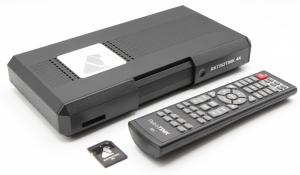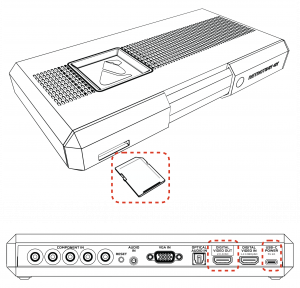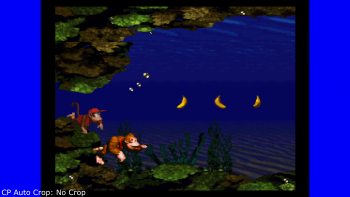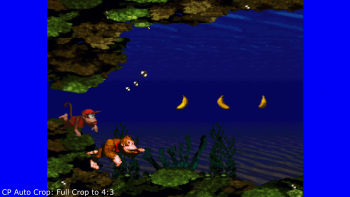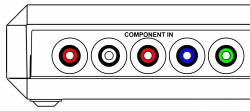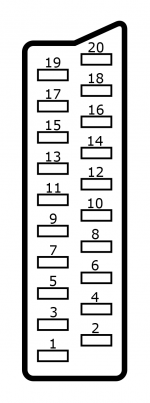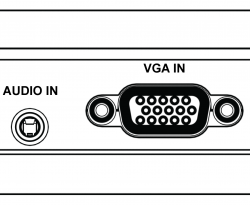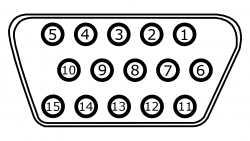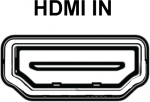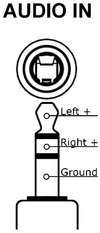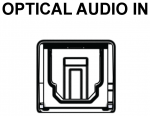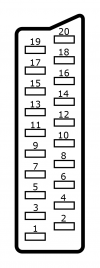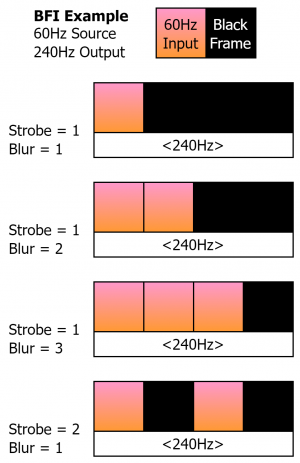AV:RetroTINK-4K: Difference between revisions
| Line 209: | Line 209: | ||
* '''Automatic Cropping''' tools are in the CP Auto Crop section. "Vertical Only" crops only the top and bottom edges, "Full Crop to 4:3" crops all four edges, and "Full Crop to 16:9" crops all four edges and sets the Aspect Correction to 16:9. Automatic Cropping isn't infallible: make sure the picture has no completely black or dark edges as this can cause the Auto Crop to crop too far! If it's incorrect, you can still adjust it yourself using the manual | * '''Automatic Cropping''' tools are in the CP Auto Crop section. "Vertical Only" crops only the top and bottom edges, "Full Crop to 4:3" crops all four edges, and "Full Crop to 16:9" crops all four edges and sets the Aspect Correction to 16:9. Automatic Cropping isn't infallible: make sure the picture has no completely black or dark edges as this can cause the Auto Crop to crop too far! If it's incorrect, you can still adjust it yourself using the manual | ||
==Tweaks, Filters and Beyond== | ==Tweaks, Filters and Beyond== | ||
Of course, there is a lot more you can do from here. Some options to explore: (these will be links to fleshed out sections of the wiki) | |||
* [[#Profiles|Choose an Expert-Crafted Optimal Profile]] | * [[#Profiles|Choose an Expert-Crafted Optimal Profile]] | ||
Revision as of 21:16, 18 November 2023
The RetroTINK-4K is an advanced video scaler from RetroTINK LLC. Building on the functionality of the RetroTINK-2X and RetroTINK-5X, the RetroTINK-4K offers high-end video scaling and processing at resolutions up to 4K60.
Overview
The RetroTINK-4K is the latest evolution of the RetroTINK line of video line doublers and upscalers. Below is a list of some standout features:
Output
- Digital Video up to 4K60
- Flexible output modes including 480p, 1080p, 1440p at various refresh rates
- Custom modelines on the SD card
- Fully buffered video (drop-free on input changes), Gen Locked and Frame Locked sync modes
- HDR10 output with full color correction to Rec. 2020
- High frame rate output modes: 1440p120, 1080p240
- Optional deep color output (10 bits at 4K60 may not be compatible with all displays)
- Up to 8-ch LPCM audio
Inputs
- Supports for virtually all analog formats:
- HD15/VGA: RGBHV, RGBS, RGsB, YPbPr, S-video and Composite
- SCART: RGBS, RGsB, YPbPr, S-video and Composite
- Rear RCA: RGsB, YPbPr and Composite
- Front Composite
- Front S-Video
- Digital Video Input supporting up to 1080p60/1200p (CVT-rb)
- Analog audio input sampled at up to 96kHz/24-bit with full gain control
- Optical TOSLINK audio input supporting 2-Ch LPCM or compressed surround
- Digital Video audio supports up to 8-ch LPCM
Analog Video
- Automatic gain calibration
- Automatic phase calibration
- Automatic input cropping to trim borders
- Full control of gain, offset and sample rate
- Console specific automatic sample rate detection (experimental feature)
- Support for a wide variety of off-spec arcade and PC boards (may require custom profiles to properly trim and center the image)
- Max input resolution of 1920x1080p60 or 1920x1200p60 CVT-rb
- Robust composite/S-video decoder with multi-region support (NTSC, PAL, PAL-60, SECAM)
Scaling
- Fully flexible, custom cropping and zooming in the horizontal and vertical space independent of other settings
- Automatic aspect ratio correction to 4:3 or 16:9
- Motion adaptive deinterlacing including film modes for 3:2 and 2:2 inverse telecine (experimental feature)
- RoTATE 90 deg CW or CCW (for 240p, 288p and 360p inputs)
CRT Simulation
- Multiple CRT beam profiles
- Fully configurable CRT beam strength and intensity modulation
- Adjustable CRT masks and strength
- Interlaced video simulation with offset scanlines
- LCD simulation patterns that automatically adapt to scaling, including non-integer factors
Image Processing
- End to end RGB pipeline with internal 12-bit precision
- Conventional gamma and approximated modes to minimize quantization error
- Advanced and fully configurable gamma and perceptual quantizer (HDR)
- Advanced color gamut transforms to simulate different display technologies
- Black frame insertion engine with customizable pattern and intensity
- Linear light processing
User Interface
- Advanced OSD menu based system
- SD Card for saving profiles, custom modelines and firmware updates
- Custom premium remote control
Alternatives
The RetroTINK-4K is a premium product designed for high-end analog and digital video upscaling. It may be insightful for some users to compare the 4K's feature set to its sister product, the RetroTINK-5X. The table below emphasizes some key improvements and features the 4K to its predecessor.
| RetroTINK-4K Versus RetroTINK-5X Feature Comparison | ||
|---|---|---|
| Feature | RetroTINK-4K | RetroTINK-5X |
| Max Output | 4K60 (3840 x 2160) | 1080p60 (1920 x 1080), Experimental 2560 x 1440p60 |
| Black Frame Insertion | Yes | No |
| High Framerate Output | Yes | No |
| Digital Video Input | Yes | No (requires digital to analog transcoding, limited support) |
| Interpolation | Advanced (Lanczos, Cubic, etc.) | Basic Bilinear and Bilinear Sharp Only |
| 1080p Input | Yes (Digital / YPbPr) | No, 1080i max input over YPbPr (limited support) |
| VGA Input | Yes / Fully Supported | No (requires VGA to SCART solution) / limited support |
| RGsB Input | Yes | No |
| Linear Light Processing | Yes | No |
| Rotation | Yes via RoTATE | No |
| HDR | Yes | Yes* (injection only, no color transforms or tone mapping) |
| Digital Audio In | Yes | Yes |
| Automatic Sample Rate Detection | Yes | No |
| Automatic Phase | Yes (advanced algorithm) | Yes (basic algorithm) |
| Automatic Gain | Yes | No (requires manual calibration) |
| Pipeline | RGB 4:4:4 at 12-bits | Oversampled YCbCr 4:2:2 at 8-bits |
| Customizable Shadow Masks | Yes (loaded from SD) | No (Hard Coded from Firmware) |
| Profile Slots | 1,000+ | 10 |
| Transferable Profiles | Yes (SD card file system) | No (manual entry profile slots) |
| Gamma Correction | Advanced controls plus HDR PQ | Basic output gamma adjustment only |
| Custom Color Gamuts | Yes | No |
| Firmware Updates | SD card file update | Requires connection to PC with FW update software |
| Non-Integer Scanline Support | Yes | Yes |
| Advanced MA Deinterlacing | Yes (1080i, adjustable thresholds) | No (480i/576i max, no customization) |
| 480i/240p Downscaling | Possible but Unsupported | Yes |
| Smoothing Filter | No | Yes (Smooth vertical interpolation) |
Getting Started
The RetroTINK-4K is designed to be powerful, yet easy to use and quick to setup. Here are some steps to get started Using the RetroTINK-4K:
- SD Card: A card is included with every RetroTINK-4K that includes the launch firmware and profiles. Please make sure this card is inserted in the device, as it is required for proper operation. If you lose the card, any FAT32 SD card 32 GB or less may be substituted.
- USB-C Power: Connect a USB-C cable supplying at least 5V/2A to the USB-C power input on the 4K.
- Video Output: Connect an HDMI™ cable (2.0 or higher / 18Gbps+) from the RetroTINK-4K output to your display.
- Video Input: Connect your device's signal to any of the RetroTINK-4K's inputs. More information on supported connections can be found in the Inputs section.
- Confirm Video: By default, the RetroTINK-4K outputs 4K60. If you don't see any picture, confirm that your display supports 4K60, or press the button on the remote that matches the resolution of your display (1080p, 1440p, or 480p). See the Remote and Output sections for more information.
- Select Your Input: Once you see the 4K's splash screen on your display, you will need to select your input. To do this, use the remote to navigate through the Input selections and choose the port and signal your device is using.
- Enjoy: Once your video source is visible, that is it! Enjoy the high quality, low latency scaling of the RetroTINK-4K. Time to play the game!
Basic Calibration
With your game up and running, you may want to consider a couple more steps:
(note that HDMI™ video sources do not require calibration)
| Auto Calibrate the Gain: Under Advanced Settings > RGB/Component ADC are the brightness controls for analog signals. Gain settings apply on a per-console basis.
| |||||||||||||||||||||||||||||||||||||||||||||||||||||||||||||||||||||||||||||||||||||||||||||||||||||||||||||||||||||||||||||||||||||||||||||||||||||||||||||||||||||||||||||||||||||||||||||||||||||||||||||||||||||||||||||||||||||||||||||||||||||||||||||||||||||||||||||||||||||||||||||||||||||||||||||||||||||||||||||||||||||||||||||||||||||||||||||||||||||||||||||||||||||||||||||||||||||||||||||||||||||||||||||||||||||||||||||||||||||||||||||||||||||||||||||||||||||||||||||||||||||||||||||||||||||||||||||||||||||||||||||||||||||||||||||||||||||||||||||||||||||||||||||||||||||||||||||||||||||||||||||||||||||||||||||||||||||||||||||||||||||||||||||||||||||||||||||||||||||||||||||||||||||||||||||||||||||||||||||||||||||||||||||||||||||||||||||||||||||||||||||||||||||||||||||||||||||||||||||||||||||||||||||||||||||||||||||||||||||||||||||||||||||||||||||||||||||||||||||||||||||||||||||||||||||||||||||||||||||||||||||||||||||||||||||||||||||||||||||||||||||||||||||||||||||||||||||||||||||||
|
|
Crop The Picture: Under Advanced Settings > Scaling / Crop Setup will be the cropping controls. The RT4K positions the image based on how it's cropped, so this is how you get it to fill the screen the way you want it to. Crop settings apply on a per-game basis, and can be done manually or with Auto Crop.
Tweaks, Filters and BeyondOf course, there is a lot more you can do from here. Some options to explore: (these will be links to fleshed out sections of the wiki)
In addition to these, there are many other adjustments, tweaks and possibilities for image manipulation to explore documented throughout this wiki. InputsThe RetroTINK-4K features inputs for a wide variety of signals and connector types. FrontThe Tink 4K offers S-Video (over Mini-Din) and Composite (over RCA) inputs in the front. The red and white RCA jacks are stereo audio inputs. Red/White front audio inputs are active when either the Front Composite or S-Video input is selected (assuming audio input override is not used). Rear RCAThe rear RCA jacks support YPbPr (component), RGsB, and CVBS (composite) inputs.
SCART
HD-15
Digital Video
3.5mm TRS Audio
Optical Audio
Alternate Audio InputsYou can override the audio from any analog source over all video sources in the RetroTINK 4k-Pro. Make your way to the Advanced Settings, select "Audio Input" under "Acquisition" and make your way to the "Input Override" option under "Source" and select the audio source you want to use. The only exception is you cannot override an analog video source with audio from Digital Video. All other combinations work. Here's a brief description of the different possible audio sources for this option:
HDMI™ OutputThe RetroTINK 4K-Pro only outputs via the Digital Video output port. Note that The RetroTINK 4K-Pro can not output through any of its analog ports. The HDMI™ Output menu allows you to set your output resolution, enable black frame insertion, change your colorspace output (colorimetry) and more. Here is a breakdown of some key functions: Output ResolutionsThe following outputs are readily supported by the RetroTINK 4K-Pro. Also noted are resolutions available by pushing their respective button on the remote. If you are unsure which resolution to use, use the buttons on the remote.
Sync LockSync Lock is a setting that decides how the RetroTINK-4K reinterprets the video timings of the source input. Triple Buffer create very high compatibility with displays and capture devices even for consoles with "imprecise" video. However, Triple Buffer mode comes at the expense of increased lag and occasional and minor judder. The lag varies between approximately 0.25 to 1.25 frames in this mode. THIS IS STOLEN FROM THE 5X WIKI AND NEEDS TO BE REWORKED FOR THE 4K Older video game consoles didn't always have perfect video timings. CRTs typically had no problems working with these variances, but these "imprecise" consoles can sometimes have trouble working with modern TVs and capture devices that conform to a more rigid standard. Some games, such as Silent Hill or Chrono Cross on the PlayStation 1, will alternate between 240p or 480i video modes if you are in-game or in the items/pause menu, respectively. On many displays, upscalers and capture devices, this will create a long delay and a "no input detected" screen for several seconds while the device reorients to the new video mode. The issue of a device taking a gameplay-harming amount of time to change between video modes has been colloquially called the "Chrono Cross" problem. These modes can be accessed in the "HDMI" menu, then adjusting the "V-Sync" option. For PAL users, it's worth noting that the Lock to 60hz feature may also be required to remove the "Chrono Cross" problem. Lock to 60hz also allows capture cards to not lose picture when nothing is output at all, such as before and after the console startup. The TINK-5X is not able to automatically switch its H. Sampling Preset when the resolution changes. If you are using one of the non-Generic presets, we recommend using the one that matches the gameplay. Triple Buffer The RetroTINK-5X Pro uses "Triple Buffer" mode to effectively eliminate the "Chrono Cross" problem and create very high compatibility with displays and capture devices even for consoles with "imprecise" video. However, Triple Buffer mode comes at the expense of increased lag and occasional and minor judder. The lag varies between approximately 0.25 to 1.25 frames in this mode. Frame Lock For those looking for the lowest possible lag, the RetroTINK-5X Pro offers a "Frame Lock" mode. With Frame Lock enabled, the RetroTINK-5X Pro uses the console's video input as its base clock and offers a fixed lag of approx. 0.25 frames. The lowered lag comes at the cost of possibly lower compatibility with some TVs and capture cards, and not protecting devices from the "Chrono Cross" problem. The RetroTINK-5X Pro defaults to Triple Buffer mode to ensure the highest compatibility for users. To toggle between Triple Buffer and Frame Lock, navigate to the HDMI settings and toggle the V. Sync (Vertical Sync) option. Gen Lock The 'Gen Lock' feature is only available with Firmware 2.73 or higher, and only on units sold after July 2021. This variance is due to a part that was substituted on account of supply shortages. Firmwares 2.73 and above will still work with older models (including newer features such as HDR), but won't display the Gen Lock feature. Similar but unique to Frame Lock Mode, Gen Lock allows the RetroTINK-5X Pro to match the input frame rate with a regenerated clock, resulting in a signal which is more stable than Frame Lock Mode. Mainly useful for 1440p+ resolutions with SDP sources (Composite/S-Video) that previously could not sync in Frame Lock. Other benefits include removing judder and composite artifacts that show up in triple buffering, as well as dejittering the SNES for displays that may otherwise not work in Frame Lock Mode. Variable Refresh Rate (VRR) Certain displays support Variable Refresh Rate, allowing them to achieve a wider range of frame rates. The RetroTINK-5X can flag its output as VRR, which improves input lag for the Frame Lock and Gen Lock V-Sync modes. For certain displays this will also enable a special low latency mode, reducing the display's input lag. ColorimetryExplain why you would choose one color space over another here / matching tink output with display/capture card expectation Black Frame Insertion (BFI)Black Frame Insertion (BFI) is a technique to improve motion clarity with high refresh rate monitors. As an example, a 60fps video source played on a 120hz monitor could have a black frame interstitially placed between every frame. The resulting "image-black-image-black" pattern can increase the perception of motion and fine details. If you have a higher refresh rate monitor, a customizable example can be viewed over at Blur Busters. To enable BFI:
More information about BFI can be found at Blur Busters. Remote
Scaling/CropThe RetroTINK-4K has robust controls to adjust size, positioning and cropping. For most users, the CP Auto Crop function will trim the unused area ProfilesProfile ManagementIncluded ProfilesCommunity ProfilesProfile TroubleshootingAdvanced SettingsAutomatic SettingsAutomatic Sampling DetectionThe RetroTINK 4k can take advantage of sampling and scaling algorithms to seamlessly change settings when it detects a horizontal resolution change. This is useful for most analog retro gaming consoles, but requires knowledge of their "Master Sampling Rate," noted below.
Once you know the master Sampling rate of your console, set that console's ADC Sample rate in the "Sample Rate Detection" menu under ADC Sample Rate, and turn both "Auto Dec. Factor" and "Auto Dec. Phase" to "On." Once you enable those options, if you know which resolutions you'll use, scroll down to that resolution to enable that horizontal resolution's detection and the RetroTINK 4K-Pro should automatically switch to a different set of settings whenever it detects that particular resolution is used. This process will help automatically set Decimation Factor and Decimation Phase in the ADC setup. Automatic Color CalibrationFor RGB and YPbPr sources ONLY. If you are able to find a sufficiently large patch of color that should be white in your game screen, make your way to the RGB/Component Setup page (click the ADC button on the remote) and make your way down to the "Auto Calibrate" option. Selecting this makes the RetroTINK 4K-Pro automatically calibrate your color based on that white patch. You may need to manually adjust the individual colors a few ticks more to get the true RGB code 255,255,255 for a color. Automatic PhaseAny game screen is sufficient for automatic phasing, but it is recommended to use the 240p Test Suite or other sufficiently patterned screen for eyeballing results. whether you've set automatic sample detection using that menu, or you manually selected Decimation Factor in the ADC page, selecting Auto-Calibrate Phase makes the RetroTINK 4K-Pro automatically select the best Decimation Phase and Sub-Phase for your current picture and should give you the sharpest results. It is recommended you run this 3-5 times to make sure the same factors and phases are consistently chosen. CP Auto CropThe RetroTINK 4K-Pro can automatically crop and set aspect ratio for an input if it is fed a sufficient game screen. Letterboxed, pillar-boxed, and window-boxed screens are not recommended. Please see what the options do below:
Image ScalingConsole Specific MethodologyNintendo NES/FamicomThe NES renders games in 256x224p. A stock NES, model number NES-001, supports composite, while most other NES consoles support RF. You will need at least a composite signal to connect with the RT4K. NES renders and outputs all audio in mono. To get correct stereo into the RT4K, you will need to use a female-to-dual-male RCA splitter, and connect both male ends to the stereo audio inputs of the RT4K. Super NES/Super FamicomThe majority of Super NES games run in 256x224 resolution, while a select few games run with a mix of the following: 512x224 in the whole screen for menus, 256x224 for most of the image while running 512x224 over certain parts of the screen to create transparency effects, or the same but using 512x224 resolution to get sharper text on the screen. It is recommended to run the Super NES in 512x224p mode to make sure you get all available detail. (https://consolemods.org/wiki/AV:RetroTINK-5X_Pro#512_%22Hi_Res%22_Games) We recommend using a Super NES model number SNS-001 or Super Famicom model number SHVC-001 and an RGB SCART cable wired for Sync-on-Luma, as this works with both of the aforementioned models. There are internal revisions of these models, noted as "1-Chip" on the motherboard, and the 1-Chip-03 does not work with Composite Sync. There is a revised model, SNS-101 and SHVC-101, also known as the Super Nintendo Junior. This model only supports composite video. [Picture Here: 1-Chip without gain adjustments vs 1-Chip with gain adjustments] As noted, there are revisions of the original model Super NES, noted by the "1-chip" on the motherboard. The 1-chip boards have sharper yet brighter video, while the non-1-chip boards have a "smudged" and slightly darker look. We encourage using the auto-gain functions in the ADC to correct the video on both models. [Picture Here: Non-1-Chip vs 1-Chip] Profile included for automatic switching between 512 and 256 in Display Aspect Ratio, for both SCART and HDRV YPbPr cables. Super GameBoyThe Super GameBoy Cartridge allows you to play original style GameBoy and GameBoy Color cartridges on your TV using the Super Nintendo, and adds borders. Once dialed in, GameBoy games are rendered in a 160x144p window inside a 256x239p canvas. [Picture Here: Generic SGB vs Optimized 15x] Profile included to maximize the GameBoy window to the screen. N64All stock N64 support Composite, all NTSC N64 support S-Video, some PAL N64 do not support S-Video, and French N64 support SECAM S-Video. All N64 have 3 levels of video processing that keeps it from being sharp:
[Picture Here: AA enabled vs AA disabled] [Picture Here: a 320 game with the trick used vs left at 640 (should be the same)] [Picture Here: a non-640 or 320 game with the trick used (should look worse)] Pokemon Stadium GameBoy TowerPokemon Stadium's GameBoy Tower allows you to play Pokemon games on your TV, just like a Super GameBoy. It also uses borders just like the Super GameBoy. The issue, however, is the scaling noted above. These games render at 160x144p inside a 256x239p canvas, which is then scaled to 640 pixels wide. You will not get a sharp picture out of this setup due to that factor alone. It is recommended to play in a generic or default profile. [Picture Here: SGB vs Pokemon Stadium] Nintendo GameCubeFor the purposes of use with the RetroTINK 4K-Pro, it is highly recommended to use a DOL-001 GameCube, which has the digital out port, and an Insurrection Industries Carby, which outputs crisp digital video and can connect to the Digital Video input port of the RT4K. If you insist on buying YPbPr cables, we can only recommend the OEM D-Terminal cable with a D-Terminal to Component adapter, or the OEM component Cable. Most GameCube Games will run at 480p, and that progressive mode is activated by holding B when the GameCube boots up a game. Swiss, the Anti-Flicker Filter, and Horizontal Frame buffer WidthWhile Most GameCube games run at 480p and progressive mode is relatively easy to access, many GameCube games use an "anti-flicker-filter" by default, which will soften the image. Most of these filters can't be turned off in-game, but the homebrew software Swiss will allow you to boot games, including your own disks, with the anti-flicker filter turned off. As an added bonus, newer versions of Swiss automatically turn the filter off and boot your game in 480p. [Picture Here: game with anti-flicker filter on vs off] [Video here: Smash Bros Melee turning the flicker filter on and off] A few GameCube games scale their image to fit the console's frame buffer before output. Swiss allows you to turn this off and shows the image at its original framebuffer width, and you can use the RT4K to scale it back, for a small sharpness gain. [picture here: Framebuffer width left alone and the framebuffer width option turned on, with the RT4K used to scale back to the intended resolution] (I don't know what game to use) 240p GamesThere are 2 GameCube games that run at 240p: Megaman X Collection, and the NES games in the Zelda Collector's Edition Promotional Disc. This means you do not have to enable 480p to run those games and can sharply scale these games on the RT4K. [Picture Here: Megaman X on Super NES vs GameCube] GameBoy Player + GameBoy InterfaceThe GameBoy Player is a popular add-on to the GameCube that allows you to play GameBoy, GameBoy Color, and GameBoy Advance games on your TV. The GameBoy Player Disk does not sharply render games onto the screen, but you can use the homebrew software GameBoy Interface to sharply render games into the RT4K. A specific flavor of GBI was created to take advantage of the Insurrection Industries Carby and the TINK 4K's Digital Video input. Please use files [Picture Here: GBA game on RT5x scaled to 4k (12x scale) vs RT4K (13x scale)] [Picture Here: GBC game on RT5x scaled to 4k (12x scale) vs RT4K (15x scale)] Profiles included for 13x scaled GBA games and 15x scaled GBC games. Nintendo WiiThe Nintendo Wii is a very versatile console: it plays GameCube Games, Wii Games, and many classic retro titles through emulators as part of the Virtual Console lineup. The Wii has easy to find YPbPr component cables and can easily support 480p across all Wii software through its component cables. The Wii only supports 3 resolutions: 720x240p, 720x480i, and 720x480p. Please read on for more information on getting the sharpest possible picture from a Wii. Profile included for basic generic output. It is recommended you use this for basic Wii use. Virtual ConsoleMany Virtual Console games output at 240p when the Wii is in SDTV mode, and they will line double to output at 480p in EDTV mode. All virtual console games scale the image to 640 pixels wide, so it is recommended you use the default or generic profiles for playing virtual console games. Also of note: NES Virtual console games are rendered many shades darker than an orignal console, as an anti-epilepsy measure. [Picture Here: Donkey Kong on Super NES vs Donkey Kong on Wii with generic settings] USBLoader GX, and Counteracting the Anti-Flicker Filter, 480p LPF, and the Framebuffer Video WidthHomebrew called USBLoader GX allows you to activate or deactivate code before running games, even on your disks. Most Wii games will apply an anti-flicker filter, even at 480p, which results in a softer picture. Use USBLoader GX's options to turn this off for Wii Games. If you wish to run GameCube games, you will need to turn the anti-flicker filter off separately in either Nintendont or Devolution, but USB-Loader GX does have these options in its menu. [Video here: Super Smash Bros Brawl's settings menu turning the anti-flicker filter on and off] There is an option in USBLoader GX called the "480p pixel fix" which makes the game look much sharper. It only works with RVL-001 models with the internal CPU-01 motherboard. [Picture here: Wii game with 480p pixel fix off vs on] You can get even sharper picture from the Wii by enabling the "Video Width: Framebuffer" option in USBLoader GX. This will make games output in their original rendering resolution, which you can then rescale using the RT4K to get a much sharper picture than originally intended at the "correct" aspect ratio. As an added bonus, NES and Super NES games will render at 512x224p with this option turned on, which you can use a doubled decimation factor to treat a game like its original 256x224 resolution, and get picture on par with their original consoles. [Picture Here: Megaman X Super NES Optimal vs Wii Optimal] Nintendo WiiUPlease use the WiiU's HDMI output. Please also note the WiiU's HDMI outputs in limited range, so please change that in the HDMI Receiver Setup Menu. Nintendo SwitchNSO Gamesit is highly recommended to use 1080p output for the NSO emulators and turning on "Pixel Perfect" in their settings under "Game Screen" and to also turn off "Show controls in game" under "Control Display," and to turn off "reproduce classic feel" on the GameBoy and GameBoy Advance apps. This way, all games output a perfectly integer scaled, line-multiplied output for their games. [Picture here: Donkey Kong Country Super NES Optimal vs Switch Optimal vs Switch no adjustments] For a 256 wide game [Picture here: Ristar Genesis on Wii Optimal vs Switch Optimal vs Switch no adjustments] for 320 wide games [picture here: Mario & Luigi Superstar Saga on GBI 13x vs Switch Optimal 13x vs Switch no Adjustments 12x] for GBA games [Picture Here: The Legend of Zelda, Oracle of Ages on GBI 15x vs Switch Optimal 15x vs Switch no adjustments 14x] for GBC games Sega Master SystemRecommended output: RGB Sega Genesis/Mega DriveRecommended output: RGB Composite effects. see this portion of the 5x wiki https://consolemods.org/wiki/AV:RetroTINK-5X_Pro#Genesis_Dithering Sega CDSega 32xMaster System Games on GenesisSega SaturnRecommended output: RGB Sega DreamcastRecommended Output: RGBHV Sony PlayStationAll Sony Playstation models support RGBS. It is recommended to use a well shielded SCART cable that uses Sync-on-Luma. Resolution SwitchingPlayStation games will switch resolutions often, usually horizontal resolutions, but occasionally vertical resolutions as well. The PlayStation is a perfect use for the Automatic Sampling Detection feature of the RT4K. To help with switching vertical resolutions quickly, please enable Triple Buffer in the RT4K's Output menu. see this part of the 5x wiki https://consolemods.org/wiki/AV:RetroTINK-5X_Pro#Resolution_Switching Profiles included will automatically switch to all resolutions. You may want to consider looking through your game collection and see if you can turn off any resolutions that you won't use, for faster response from the auto sampling detection. Sony PlayStation 2The PS2 outputs 240p, 480i, 480p, and 1080i and supports RGB as well as YPbPr. For simplicity, it is highly recommended to use YPbPr cables because the RT4K will automatically detect and switch to all those resolutions seamlessly. The PS2 will use RGBS for 240p and 480i, but will switch to RGsB for any resolutions above that. While the RT4K supports RGsB, it does not automatically switch from RGBS to RGsB, you will need to change the input manually. All PS2 games will output either 512 pixels wide or 640 pixels wide. [sic] PS1 Backwards CompatibilityPS1 games on PS2 use a different set of optimal sampling numbers than the PS1 console. Sony PlayStation PortablePSP models PSP-2000, PSP-3000, and PSP-N1000 (aka PSP GO) can output to a display, and it is highly recommended to use component cables with the RT4K. PSP games are rendered at 480x272p. When they are displayed on a television with component cables, they render a 480x272p picture inside of a 720x480p canvas. You can use the RT4K to upscale the image to fit the screen. You will get the sharpest integer scaled picture at the expense of cutting off 2 vertical pixels. [Picture here: PSP left alone (4.5x scale) vs PSP scaled to 8x] Playstation ClassicsPlayStation Classics are PS1 games played on the PSP. You can render these games in their original resolution by enabling interlaced output in the display settings. [picture here: ps1 console optimized vs ps1 classic] Sony PlayStation 3The PS3 supports HDMI and it is recommended to use that for the sharpest possible picture with the RT4K. While the PS3 does support up to 1080p using YPbPr, the standard is put to its limits and doesn't provide a picture as sharp as HDMI. PS3 will automatically switch games to their highest automatically supported and selected resolution and the RT4K supports all inputs the PS3 supports. [Picture Here: HDMI vs YPbPr] PS1 ClassicsPS1 games render in 480p, but scale the image to 4:3 aspect ratio. For the sharpest picture, it is recommended to turn off "PS Upscaling" in the PS3's settings and to use prescale 1/2 in the RT4K's Scaling/Crop Menu. [Picture Here: PS1 console optimized vs ps1 classic] Sony Playstation TVThe PSTV allows you to play Vita, PSP, and PS1 Classics on your TV through HDMI. By default, all output from the PlayStation TV is soft because of the following factors:
To counteract this for the sharpest possible picture, we highly recommend installing custom firmware on your PSTV and installing the Sharpscale plugin to counteract all the above effects applied to the PSTV. Sharpscale pluginSee an overview of sharpscale here. The following suggestions only work when sharpscale is enabled with the following options: [picture of sharpscale plugin with the following settings enabled]
Vita GamesWhen Playing a Vita Game, the PSTV outputs a 960x544p picture inside of a 1280x720p canvas. Use the following settings to get the sharpest integer scaled picture for Vita Games. These settings cut off 4 vertical pixels from Vita games.
[Picture Here: Steamworld Dig 2 with sharpscale disabled vs enabled and optimized] PSP GamesThe PSTV also outputs a 960x544p picture inside of a 1280x720p canvas. Use the following settings to get the sharpest integer scaled picture for PSP games. These settings cut off 2 vertical pixels from PSP games.
[Picture Here: Final Fantasy IV with sharpscale disabled vs enabled and optimized] PS1 ClassicsSharpscale will allow you to get the sharpest picture for ps1 games, but the behavior is not optimal. With the Integer Scaling Mode setting enabled in Sharpscale, some resolutions will use the full vertical space, and others will only scale to 480 vertical pixels inside 720p. it is recommended you look at the resolutions supported by your game before you use sharpscale with the RT4K and see if it is worth avoiding the headache. If you set PS1 Aspect Ratio to 4:3, the PSTV will force all games to fit, but they will not evenly scale horizontally, resulting in shimmering pixels. [Picture Here: PS1 console optimized vs pstv optimized] Sony Playstation 4TurboGrafx-16/PCEngineMicrosoft XboxPreferred output: YPbPr. Up to 720p available with custom firmware Microsoft Xbox 360Preferred Output: HDMI where available Alternate Output: YPbPr for any Xbox 360 that doesn't support HDMI. Microsoft Xbox OneTroubleshootingProfile RepositoryGeneric Profiles
Downscaling
Console Specific3DO Interactive Multiplayer
Atari Jaguar
Microsoft Xbox
Microsoft Xbox 360
Neo Geo AES
Nintendo Entertainment System (NES)
Super Nintendo / Super Famicom
Nintendo 64
Nintendo Gamecube
Nintendo Wii
Nintendo Wii U
Nintendo Switch
Phillips CDi
Pioneer LaserActive
Sega Master System
Sega Genesis / Megadrive
Sega Saturn
Sega Dreamcast
Sony PlayStation 1
Sony PlayStation 2
Sony PlayStation 3
Sony PSP
Sony PlayStation TV/Vita TVThe Playstation TV profiles require a hacked PSTV and the Sharpscale plugin to take advantage of the potential sharpness the PSTV can give. If your PSTV is not hacked, please use the default profile. For the following profiles, please set the following options in Sharpscale:
The following profiles require a slight change in Sharpscale settings. These profiles are best used with games that stick to one resolution for the majority of their gameplay. Do not use these with Chrono Cross or Silent Hill, their menus will cut off vertically
TurboGrafx-16 / PC Engine
Classic Mini Consoles
Analogue Pocket
Computer SpecificFM TownsFM Towns computers once hitting white desktop variants output different video displays with some models performing internal upscaling conversions from 24khz to 31khz as well as some models performing 15khz to 31khz with adjustments in the TBIOS configuration file. EA and Pentium type desktops only output 31khz video modes.
The below profiles are meant for all towers, UX, UG, UR, HG and HR models which are all models that do not perform internal conversion.
Sharp X68000Sharp X68000 is unique with its outputs primarily being 15khz and 31khz. A few games have hidden selectable 24khz display modes.
PC-8801PC-8801 computers will output either 15khz or 24khz depending on the dipswitch settings in the back. If dipswitch settings are incorrect, games will refuse to boot and crash the computer.
The 15khz VGA detection in the RT4K works very well for PC8801 and most video modes won't require a profile.
Advanced FeaturesDeinterlacer / Film Mode SetupMotion Adaptive SettingsMotion Adaptive settings apply only to the Motion Adaptive Deinterlacing mode, allowing you to adjust it to your liking.
NotesDeinterlacer -> -> Motion Adaptive Settings -> Sensitivity (medium and high options might be might be reversed) Controls combing effect at costs of sharpness. Low = less combing.
Basically controls how the "bob" portion of the MA is calculated. The bob is either taken from the line above, line below or the average of the upper and lower lines BFI. It's a matter of preference. I think either Top or Bottom interpolator looks a little sharper. Average is softer In the end it doesn't matter too much because Bob is only used during motion when it is hard to see detail anwyays
This is a little complicated to explain... but let me try basically symmetric adds one frame of lag but the motion detection may be better. Because it is looking "one field into the future" idk if its really better tho in real life
-Strobe: How much the frame is divided down (i.e. 1 = divide by 2, 2 = divide by 3, 3 = divide by 4) from input to output -Blur: How many frames are ON vs OFF. So let's say we are converting 60 Hz -> 240 Hz. Blur = 1, ON, OFF, OFF, OFF. Blur = 2 is ON, ON, OFF, OFF -LCD Saver - inverts the pattern of the BFI to avoid renetion. But every few minutes u will see a flicker Custom Mode Lines #RT4K Custom Mode Line Format #H active, H front porch, H sync, H total blank, polarity (1 = pos, 0 = neg) #V active, V front porch, V sync, V total blank, polarity (1 = pos, 0 = neg) #Nominal frame rate (floating point) #Text name Launch Informationhttps://www.retrotink.com/post/introducing-the-retrotink-4k User GuidesCustom CRT Shadow MasksThe RT4K allows for the use of custom CRT shadow mask overlays.This is primarily intended to give an effect similar to CRT slot masks, as opposed to the pictures scanlines.
Downscaling (pre-scale) BasicsExplain Downscaling here RetroTINK-4K GUI MapBasic SetupInput SelectionMore information concerning inputs can be found in the Inputs section.
Digital Video OutputMore information concerning outputs can be found in the Outputs section.
Profiles
Advanced SettingsScaling/Cropping
Processing / Effects
Color Correction
Black Frame Insertion
Deinterlacer / Film
AcquisitionDigital In Receiver
RGB / Component ADC
Sample Rate Detection
SDP Decoder
Audio Input
SystemOSD / Firmware
Status
DeviceStatusSystem Status Page 1:
System Status Page 2:
System Status Page 3:
Diagnostic Consoleto do
About
|
||||||||||||||||||||||||||||||||||||||||||||||||||||||||||||||||||||||||||||||||||||||||||||||||||||||||||||||||||||||||||||||||||||||||||||||||||||||||||||||||||||||||||||||||||||||||||||||||||||||||||||||||||||||||||||||||||||||||||||||||||||||||||||||||||||||||||||||||||||||||||||||||||||||||||||||||||||||||||||||||||||||||||||||||||||||||||||||||||||||||||||||||||||||||||||||||||||||||||||||||||||||||||||||||||||||||||||||||||||||||||||||||||||||||||||||||||||||||||||||||||||||||||||||||||||||||||||||||||||||||||||||||||||||||||||||||||||||||||||||||||||||||||||||||||||||||||||||||||||||||||||||||||||||||||||||||||||||||||||||||||||||||||||||||||||||||||||||||||||||||||||||||||||||||||||||||||||||||||||||||||||||||||||||||||||||||||||||||||||||||||||||||||||||||||||||||||||||||||||||||||||||||||||||||||||||||||||||||||||||||||||||||||||||||||||||||||||||||||||||||||||||||||||||||||||||||||||||||||||||||||||||||||||||||||||||||||||||||||||||||||||||||||||||||||||||||||||||||||||||
